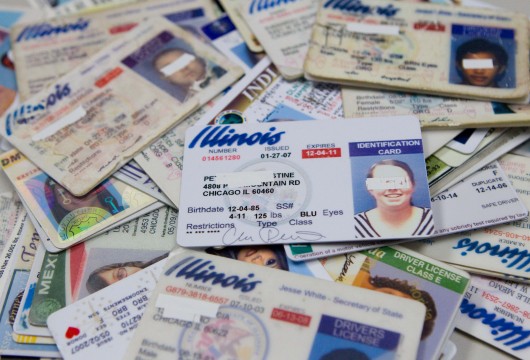
A pile of confiscated fake IDs. Some OSU students said they have used a fake ID in the campus area before.
Credit: Courtesy of MCT
Some students are willing to risk jail time and fines for a buzz by using fake IDs in Ohio State’s campus area.
The Ohio Investigative Unit made 24 arrests in Franklin County in the area of fictitious identifications in 2013, Eric Wolf, agent in charge of administration for the OIU, said in an email.
It is illegal to purchase or consume alcohol under the age of 21 in Ohio.
Attempting to use an ID that is not a person’s own or possessing or attempting to use an ID that is fictitious are prohibited acts under the Ohio Revised Code section 4507.30(c)(a), Wolf said.
These prohibited acts are first degree misdemeanors, punishable by up to six months in jail and/or a $1,000 fine, Wolf said.
Some OSU students, though, said they used fake IDs for years without facing consequences.
Kathryn Chapman, a fourth-year in linguistics, said she obtained her older sister’s ID at 19 to be able to get into bars on a spring break trip.
“Her only stipulation was that I had to cut my bangs to look more like her,” Chapman said.
Her sister’s ID continued to get her frequent access into bars around campus until she was 21, Chapman said.
She could only recall three times where she had difficulty passing the ID off as her own and attributes her success to a lack of scrutiny by those checking IDs.
“My sister’s eye color is different than mine, my sister tans — I’m very pale and she’s very dark, and after I gained some confidence using the ID, I grew out my bangs so they were completely different from my sister’s,” Chapman said.
Not all of those who check IDs let a fake ID pass so easily, however, said one seasoned bar employee.
Cruz Davis, bartender, bouncer and doorman for Bier Stube, a small bar at 1479 N. High St., has been checking IDs for almost five years.
“I usually check everything,” Cruz said.
Pulling out his own ID for reference, Cruz listed color tint, holograms, fine print on the back of the ID and lamination as some of the most telling indicators that an ID might be fictitious.
Cruz said he also compares the picture and information listed to the person standing in front of him for discrepancies in eye color, hair color, weight and facial structure.
Keeping the bar out of trouble and in business is motivation to be vigilant with IDs, Cruz said, who added that fake IDs are used most commonly at certain times of the year.
“Fake IDs are out all the time during the first couple weeks of school and during football season,” Cruz said. “When kids want to come out and party at bars for the games, you see lots and lots and lots of fake IDs.”
In a later Facebook message, Cruz said he had turned away three fake IDs Saturday night by 1 a.m. Sunday.
Procuring a fake ID used to be a lot easier on OSU’s campus years ago, said Richard Morman, deputy chief of University Police.
“Several years ago, we used to get quite a few calls into the residence halls about people making fake IDs and selling them because they were easier to duplicate without the holograms that are on them now,” Morman said.
A Polaroid camera and a big cardboard cutout were practically all you needed to manufacture a fake Ohio driver’s license at that time, Morman said.
Some students without fake IDs, though, said there are other ways to drink while underage.
Nick Engle, fourth-year in aviation management, said he never used a fake ID while he was underage.
“Most of my friends are older so I just had them buy booze for me,” Engle said. “If that hadn’t been the case, I probably would have been tempted to go get a fake ID so I could drink anyway.”
OSU’s Undergraduate Student Government released a statement Tuesday that said it supported Ohio House Bill 392 that would “create an Under-21 Alcohol Good Samaritan policy across the state of Ohio.”
The policy would allow people under the legal age of consumption to contact emergency services if needed without the fear of repercussions or incrimination.
“This Good Samaritan policy will create an environment that encourages students to call for help and make safe and smart decisions. USG supports Good Samaritan policies for Ohio State’s campus and off-campus areas as well as at universities throughout the state of Ohio,” the USG statement read.


